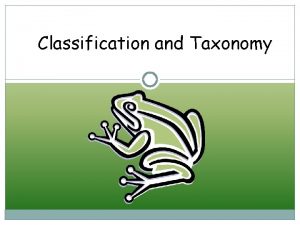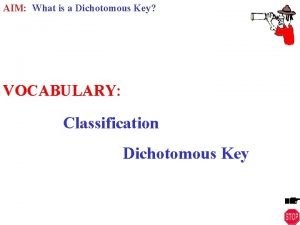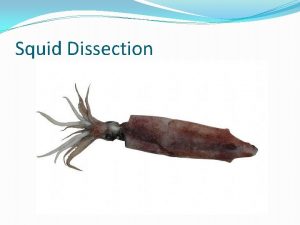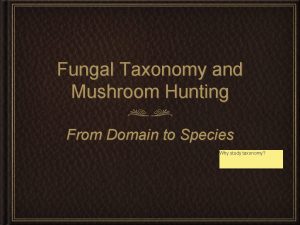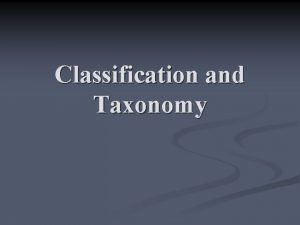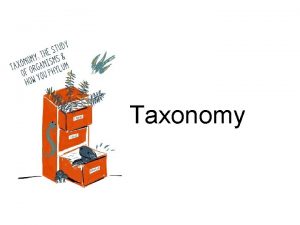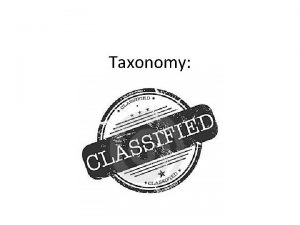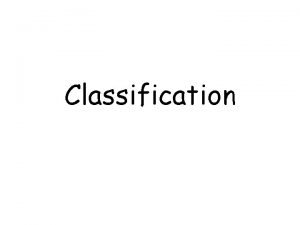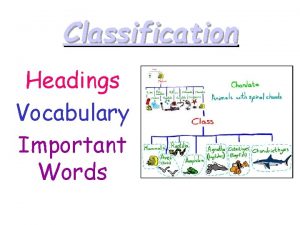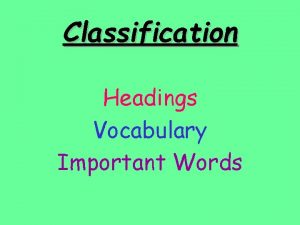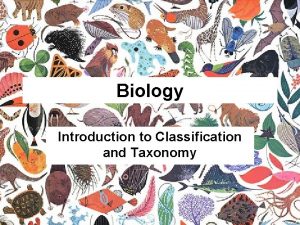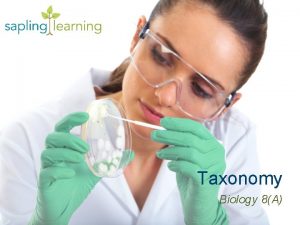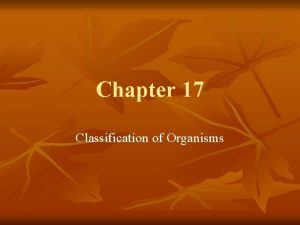CLASSIFICATION Ch 17 What is Taxonomy Taxonomy The
















































- Slides: 48

CLASSIFICATION Ch. 17

What is Taxonomy?

Taxonomy • The science of classifying living things.

What are 2 reasons we classify?

• To make things easier to find. • To show things are alike. • To be able to accurately name organisms.

What are 2 problems associated with classification?

2 Problems • There are many different life forms. • People disagree on how to classify.

Early Classification Systems

Who was the first person to classify organisms?

ARISTOTLE • Divided organisms into 2 groups: – Plants and animals

Aristotle further divided plants into groups based on size. Herbs Trees (short) Shrubs (medium) (tall)

Aristotle divided animals into groups based on habitat. air land water

What scientist developed the classification system we use today?

Carolus Linnaeus • Swedish botanist. • Classified organisms based on their physical and structural similarities. • Two kingdoms- plant and animal. • 7 taxons or levels of organization. • Developed binomial nomenclature

What are the classification groups (used today) in order from largest to smallest

Classification Hierarchy • • Domain—largest group (recently established) Kingdom Phylum (“Division” used for plants) Class Order Family Genus Species—smallest group (exceptions)

• King • Phillip • Came • Over • For • Good • Spaghetti


The Linnaean classification system has limitations. • Linnaeus taxonomy doesn’t account for molecular evidence. – The technology didn’t exist during Linneaus’ time. – Linnaean system based only on physical similarities.

• Physical similarities are not always the result of close relationships. • Genetic similarities more accurately show evolutionary relationships.

How are organisms given names?

Binomial Nomenclature • Two-part naming system devised by Linnaeus (still used today)


What are the rules for naming organisms?

Rules for Naming Organisms – 1 st word is the genus and is always capitalized. – 2 nd word is the species and is never capitalized. – Latin is always used. – Name is always written in in italics.

Binomial Nomenclature

Why is it important to use scientific names?

Why use Scientific Names? • Latin is a universal language. • They seldom change/less confusion. • Show relationship of a species.


MODERN TAXONOMY RULES • Evolutionary relationship among organisms • Chromosome structure/karyotype • Reproductive potential • Biochemical makeup • Embryological development

Classification is always a work in progress. • The tree of life shows our most current understanding. • New discoveries can lead to changes in classification. – Until 1866: only two kingdoms, Animalia and Plantae Animalia – 1866: all single-celled organisms moved to kingdom Protista Plantae Protista – 1938: prokaryotes moved to kingdom Monera – 1959: fungi moved to own kingdom Archea Fungi – 1977: kingdom Monera split into kingdoms Bacteria and Archaea Bacteria

3 -DOMAIN SYSTEM (used today) • Domain Archaea—ancient bacteria; live in extreme environments – (Kingdom Archaea) • Domain Bacteria—most common bacteria – (Kingdom Bacteria) • Domain Eukarya—eukaryotic organisms – 4 kingdoms


E. coli

What are the 4 kingdoms in the Domain Eukarya?

Kingdoms in Domain Eukarya – Kingdom Protista – Kingdom Fungi – Kingdom Plantae – Kingdom Animalia



Dichotomous Key • A tool used to identify organisms • Characteristics given in pairs • Read both characteristics and either go to another set of characteristics OR identify the organism

Example of Dichotomous Key • 1 a Tentacles present – Go to 2 • 1 b Tentacles absent – Go to 3 • 2 a Less than 8 tentacles – Hydra • 2 b More than 8 tentacles–Go to 3 • 3 a Tentacles hang down – go to 4 • 3 b Tentacles upright–Sea Anemone • 4 a Balloon-shaped body–Jellyfish • 4 b Body NOT balloon-shaped - 5

KEY CONCEPT Modern classification is based on evolutionary relationships. Pangolin

Cladistics is classification based on common ancestry. • Phylogeny is the evolutionary history for a group of species. – evidence from living species, fossil record, and molecular data – shown with branching tree diagrams

• Cladistics is a common method to make evolutionary trees. – classification based on common ancestry – species placed in order that they descended from common ancestor Armadillo Glyptodon

• A cladogram is an evolutionary tree that proposes how species may be related to each other through common ancestors. – A clade is a group of species that shares a common ancestor. – Each species in a clade shares some traits with the ancestor. – Each species in a clade has traits that have changed.

• Derived characters are traits shared in different degrees by clade members. 1 Tetrapoda clade – basis of arranging species in cladogram – more closely related species share more derived characters – represented on cladogram as hash marks 2 Amniota clade 3 Reptilia clade 4 Diapsida clade 5 Archosauria clade FEATHERS & TOOTHLESS BEAKS. SKULL OPENINGS IN FRONT OF THE EYE & IN THE JAW OPENING IN THE SIDE OF THE SKULL OPENINGS BEHIND THE EYE EMBRYO PROTECTED BY AMNIOTIC FLUID FOUR LIMBS WITH DIGITS DERIVED CHARACTER

• Nodes represent the most recent common ancestor of a clade. • Clades can be identified by snipping a branch under a node. CLADE 1 Tetrapoda clade 2 Amniota clade 3 Reptilia clade 4 Diapsida clade 5 Archosauria clade FEATHERS AND TOOTHLESS BEAKS. SKULL OPENINGS IN FRONT OF THE EYE AND IN THE JAW OPENING IN THE SIDE OF THE SKULL OPENINGS BEHIND THE EYE EMBRYO PROTECTED BY AMNIOTIC FLUID NODE FOUR LIMBS WITH DIGITS DERIVED CHARACTER

Molecular evidence reveals species’ relatedness. • Molecular data may confirm classification based on physical similarities. • Molecular data may lead scientists to propose a new classification. • DNA is usually given the last word by scientists!!!

Derived Characters: Motor Wings Wheels Passengers enclosed Clades: Motorcycle Car Walking Bicycle airplane
 Kendall's and marzano's new taxonomy verbs
Kendall's and marzano's new taxonomy verbs Contributions to classification/taxonomy aristotle linnaeus
Contributions to classification/taxonomy aristotle linnaeus Classification and dichotomous key
Classification and dichotomous key Horse kingdom classification
Horse kingdom classification Define dichotomous key
Define dichotomous key Squid domain kingdom
Squid domain kingdom Domain taxonomy
Domain taxonomy Hình ảnh bộ gõ cơ thể búng tay
Hình ảnh bộ gõ cơ thể búng tay Ng-html
Ng-html Bổ thể
Bổ thể Tỉ lệ cơ thể trẻ em
Tỉ lệ cơ thể trẻ em Chó sói
Chó sói Thang điểm glasgow
Thang điểm glasgow Alleluia hat len nguoi oi
Alleluia hat len nguoi oi Các môn thể thao bắt đầu bằng tiếng nhảy
Các môn thể thao bắt đầu bằng tiếng nhảy Thế nào là hệ số cao nhất
Thế nào là hệ số cao nhất Các châu lục và đại dương trên thế giới
Các châu lục và đại dương trên thế giới Cong thức tính động năng
Cong thức tính động năng Trời xanh đây là của chúng ta thể thơ
Trời xanh đây là của chúng ta thể thơ Mật thư tọa độ 5x5
Mật thư tọa độ 5x5 101012 bằng
101012 bằng Phản ứng thế ankan
Phản ứng thế ankan Các châu lục và đại dương trên thế giới
Các châu lục và đại dương trên thế giới Thể thơ truyền thống
Thể thơ truyền thống Quá trình desamine hóa có thể tạo ra
Quá trình desamine hóa có thể tạo ra Một số thể thơ truyền thống
Một số thể thơ truyền thống Cái miệng nó xinh thế
Cái miệng nó xinh thế Vẽ hình chiếu vuông góc của vật thể sau
Vẽ hình chiếu vuông góc của vật thể sau Nguyên nhân của sự mỏi cơ sinh 8
Nguyên nhân của sự mỏi cơ sinh 8 đặc điểm cơ thể của người tối cổ
đặc điểm cơ thể của người tối cổ Thế nào là giọng cùng tên
Thế nào là giọng cùng tên Vẽ hình chiếu đứng bằng cạnh của vật thể
Vẽ hình chiếu đứng bằng cạnh của vật thể Tia chieu sa te
Tia chieu sa te Thẻ vin
Thẻ vin đại từ thay thế
đại từ thay thế điện thế nghỉ
điện thế nghỉ Tư thế ngồi viết
Tư thế ngồi viết Diễn thế sinh thái là
Diễn thế sinh thái là Dạng đột biến một nhiễm là
Dạng đột biến một nhiễm là Số nguyên tố là gì
Số nguyên tố là gì Tư thế ngồi viết
Tư thế ngồi viết Lời thề hippocrates
Lời thề hippocrates Thiếu nhi thế giới liên hoan
Thiếu nhi thế giới liên hoan ưu thế lai là gì
ưu thế lai là gì Hổ sinh sản vào mùa nào
Hổ sinh sản vào mùa nào Khi nào hổ mẹ dạy hổ con săn mồi
Khi nào hổ mẹ dạy hổ con săn mồi Hệ hô hấp
Hệ hô hấp Từ ngữ thể hiện lòng nhân hậu
Từ ngữ thể hiện lòng nhân hậu Thế nào là mạng điện lắp đặt kiểu nổi
Thế nào là mạng điện lắp đặt kiểu nổi

